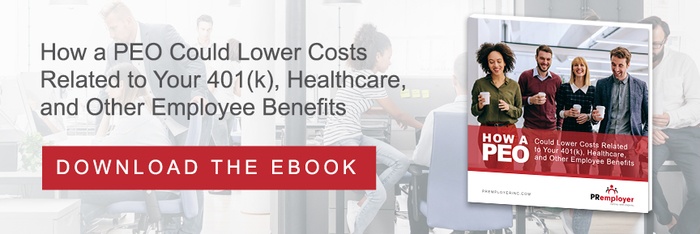
Why do businesses use Professional Employer Organization (PEO)?
One major reason: They deliver the highest ROI of any HR outsourcing solution. In fact, according to a report by the National Association of Professional Employer Organizations (NAPEO), firms who partner with a PEO gain an ROI of about 27.2%.
More than half of these cost savings come from the PEO's unique use of co-employment.
How is this ROI Calculated?
The figure above is calculated using a typical ROI formula of the net benefit of the investment divided by the cost, in this case, the fees you pay to the PEO. This only includes tangible benefits, such as cost-savings on workers’ compensation insurance. It does not even take into account less quantifiable values like lowered employee turnover. In other words, the ROI is actually very conservative, and the overall value is likely to be much higher.
For this calculation specifically, the NAPEO took five different categories of HR-related costs and compared them to the average price of being a PEO client. Based on this, a typical client saves $1,272 for every $1,000 spent on PEO services.
So, what are these cost savings, and how does a PEO help?
HR Personnel Costs
Partnering with a PEO does not replace your existing in-house HR team. However, a PEO can help you delay or avoid expanding the team as your company grows.
Additionally, the PEO can handle routine, tedious tasks such as payroll efficiently, freeing up HR time for more important things, and reducing the risk of HR tasks spilling over onto the owner or admin staff.
Health Benefits
For smaller companies, the cost of group health insurance can be prohibitive. Premiums are based in part on the size of your company, with smaller employers paying more. Partnering with a PEO can drop your health benefit costs by 37%, or an average of $654 per FTE. This is in part because of simple economies of scale. Through co-employment, the PEO is able to use the bargaining power of all of their clients to negotiate a better rate. This means you can get a better health plan for lower costs.
A good health plan is vital to attracting top talent, and poor benefits increase turnover when employees look elsewhere because their healthcare costs are getting too high. PEOs can get your employees onto a plan that has a lower deductible and higher limits that will help your employees get the care they need.
Workers' Compensation
A PEO can help you set up and maintain return-to-work programs. These allow an employee to return faster after an injury by developing a program that may involve lighter duty, fewer or more flexible hours. A proper return-to-work program reduces the cost of each workers' compensation claim by reducing the amount of income lost by the injured employee. It can also reduce turnover by ensuring that a good employee stays after an accident rather than having to seek another, easier job elsewhere.
A good PEO will also offer good safety training, appropriate to your injury. You won't have to devote time to developing your own program. The PEO will provide good quality training, which reduces workers' comp claims, downtime, and productivity loss related to accidents. When an accident happens, productivity is lost by the injured employee, and those around them as morale dips and people worry about their coworker.

Lowered Turnover
PEO clients experience noticeably lower employee turnover. This affects both voluntary (10.5%) and involuntary (9.1%) turnover.
Employee turnover is a major cost driver; every time you have to hire a new person, you have to spend money and time on recruiting, onboarding, and training. Background checks and drug testing add to these costs. One study estimated that the typical cost of replacing an employee is 38% of their salary. This figure includes, in addition to hiring costs, the cost of the separation process and an estimate of the loss of productivity from the disruption in workflow, and from the fact that new employees are generally less productive until they are up to speed.
Every time you replace an employee, you also lose institutional memory, which is intangible but valuable.
Other Savings
While NAPEO’s report covered the above categories, it ignored several other ways that best-in-class PEOs can save companies money.
For instance, many PEOs that offer 401k plans allow companies to join their retirement master plan in a similar manner to how PEOs allow companies to enter their health insurance master plan. Due to economies of scale, companies pay less and get the discounts associated with multi-employer plans. Clients of PEOs do not have to pay any administrative fees, audit fees, or charges for annual discrimination testing.
Alternatively, many best-in-class PEOs provide a Learning Management System (LMS) free of charge. This means not having to pay for specialized software or training costs. It also means no payments for continuing education for management.
So, on average, a PEO client gets an ROI of 27.2%. This is an average, meaning many PEOs can get you an even higher ROI, depending on the specific needs of your company and the services they offer. This is a higher ROI than any other HR outsourcing option and higher than keeping everything in-house. It's clear that for many small companies, partnering with a PEO is the answer to affordable HR services and providing a better environment for employees.

